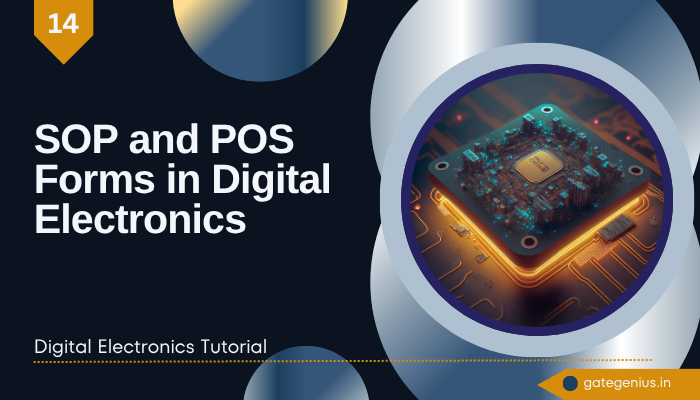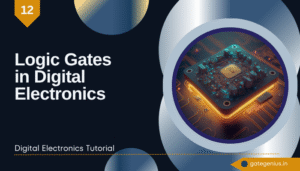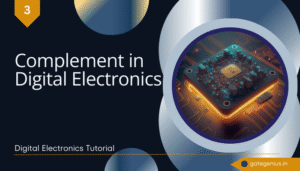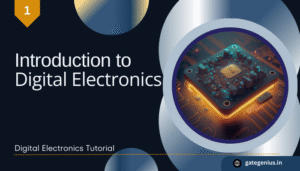When working with Boolean algebra in digital electronics, two important standard forms are SOP (Sum of Products) and POS (Product of Sums). These forms play a vital role in simplifying logic expressions and designing digital circuits.
The SOP in digital electronics is a method where logical expressions are written as a sum (OR) of multiple product (AND) terms. It is especially useful when the output is 1 (true) for most of the input combinations. Engineers often use SOP form because it’s easier to implement using basic AND and OR gates and is directly derived from the truth table by focusing on the rows where the output is high.
On the other hand, the POS in digital electronics involves writing expressions as a product (AND) of sum (OR) terms. This form is suitable when the output is 0 (false) for most of the input cases. It is preferred in situations where minimizing the number of logic gates or inverters is critical, especially when using NOR gates or NAND gate-based designs.
What is SOP (Sum of Products) Form?
The SOP form, or Sum of Products, is a standard way of expressing Boolean expressions. In SOP, we write the expression as a sum (OR operation) of product terms (AND operations). Each product term corresponds to a row in the truth table where the output is 1.
Example:
Consider a function F(A, B) with the following truth table:
| A | B | F |
| 0 | 0 | 0 |
| 0 | 1 | 1 |
| 1 | 0 | 1 |
| 1 | 1 | 0 |
From the table, F is 1 when (A=0, B=1) and (A=1, B=0).
So, the SOP expression will be:
F = A’B + AB’
This is the simplified SOP expression that represents the output using only the rows where the result is 1.
What is POS (Product of Sums) Form?
The POS form, or Product of Sums, is another way to write Boolean expressions. In this format, we take the product (AND operation) of sum terms (OR operations). Each sum term corresponds to a row in the truth table where the output is 0.
Example:
Using the same truth table:
| A | B | F |
| 0 | 0 | 0 |
| 0 | 1 | 1 |
| 1 | 0 | 1 |
| 1 | 1 | 0 |
F is 0 when (A=0, B=0) and (A=1, B=1).
So, the POS expression will be:
F = (A + B)(A’ + B’)
This form highlights the 0 outputs using OR operations, and then we AND them together.
Key Differences Between SOP and POS in Digital Electronics
| SOP (Sum of Products) | POS (Product of Sums) |
| Uses minterms (output = 1) | Uses maxterms (output = 0) |
| Expression is OR of ANDs | Expression is AND of ORs |
| Easier to implement using NAND gates | Easier to implement using NOR gates |
| Ideal for active-high outputs | Ideal for active-low outputs |
Conversion from Truth Table
- SOP: Identify the rows where the output is 1. Write a product (AND) term for each row using the variables. Then OR all those terms.
- POS: Identify the rows where the output is 0. Write a sum (OR) term for each row using the variables. Then AND all those terms.
Implementation in Logic Circuits
- SOP expressions are generally implemented using AND gates followed by OR gates.
- POS expressions are implemented using OR gates followed by AND gates.
- These forms are the basis of designing combinational circuits like multiplexers, decoders, encoders, and more.
Common Use-Cases
In digital electronics, POS (Product of Sums) form is widely used in situations where the output has fewer 0s, making it efficient for minimizing logic expressions through maxterms. It is particularly helpful when designing circuits that require simplified logic with fewer high states (1s), such as active-low outputs.
Here are some key use-cases and considerations:
- Efficient for outputs with fewer 0s: POS is ideal when the logic function has mostly 1s and only a few 0s. This reduces the number of maxterms required in the expression.
- Used in Active-Low Logic Design: Many digital systems operate with active-low outputs where logic ‘0’ signifies an active state. POS is naturally suited for such designs.
- Useful in NOR Gate Implementations: Since NOR gates are universal gates, POS expressions can be directly implemented using them, reducing circuit complexity and cost.
- Suitable for Fault Detection Circuits: In fault-tolerant systems, detecting errors often depends on conditions being false (logic 0). POS expressions help design these circuits efficiently.
- Applied in Simplification using K-Map: When simplifying Boolean functions with the help of Karnaugh Maps (K-Map), if you group the 0s (instead of 1s), you get the POS form of the expression.
- Preferred in Memory Circuit Design: Some memory circuits and storage devices internally operate based on logic low (0) activations, where POS representations are more natural.
Frequently asked questions?
Q1. What is the main difference between SOP and POS in Boolean algebra?
SOP uses the combination of ANDed terms ORed together, while POS uses ORed terms ANDed together.
Q2. When is SOP preferred over POS in digital elctronics?
SOP is preferred when there are fewer 1s in the output, making the expression more concise.
Q3. What logic gates are commonly used in SOP circuits?
SOP circuits mainly use AND gates followed by OR gates.
Q4. How is a POS expression implemented using logic gates?
POS expressions are implemented using OR gates for sum terms, followed by an AND gate.
Q5. Can we convert SOP to POS and vice versa?
Yes, using Boolean algebra and De Morgan’s theorems, you can convert SOP to POS and vice versa.
Conclusion
Understanding SOP and POS forms is fundamental in digital electronics. These two standard representations simplify logic expressions, help in circuit design, and enhance clarity when working with Boolean functions. Whether you’re a student or a professional, mastering these concepts will improve your problem-solving ability and make complex logic circuits much easier to handle.
I hope you understand the SOP and POS Forms in Digital Electronics. So don’t forget to share this post with friends and anyone preparing for the GATE, UGC NET exams, or studying at the university.



